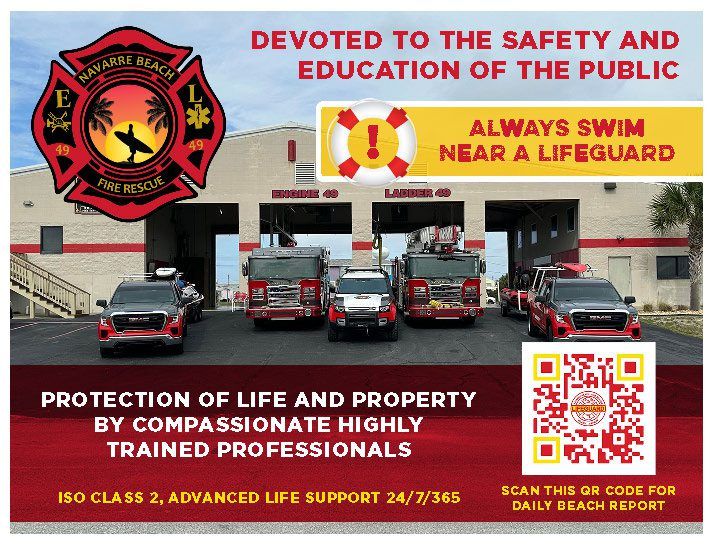Beach Safety & Info
Sugar White Sands
Why is the sand on Navarre Beach and across the Emerald Coast so white that it looks like grains of sugar? This quartz-rich sand actually washed down from the Appalachian Mountains by way of the Apalachicola River, where it entered the Gulf of Mexico and eventually made its way onto our shores. This sand is pure, white quartz crystals ground into perfect granules, leaving the sand powdery soft, and even squeaking, under your toes! We hope you will love our beaches as much as we do!
According to Santa Rosa County ordinances, the following rules apply to Navarre Beach:
Remove all items used for swimming, sunbathing or recreation two hours after dusk, and keep them off the beach until two hours after sunrise.
No camping.
No firearms.
No glass containers.
Remove trash.
No pets.
No abusive, threatening, indecent or disorderly conduct.
No campfires.
Do not destroy sea oats.
Stay off the dunes.
No fireworks.
Do not disturb other visitors with radios, TVs, musical instruments or other noise-producing devices.
No public address systems.
No nudity.
No vehicles on the beach.
No watercrafts, surfboards and similar objects within
the public swimming area.
No fishing within the public swimming area.
And, it is always a good idea to wear sunscreen or protect your skin
with clothing.

Rip Currents

Safety Tips
A difference in water color. The water may be murkier from increased sediments or appear darker because it is deeper.
The waves may appear to be larger and choppier.
Foam or objects are carried directly out to sea, or debris or vegetation may appear perpendicular to the shore at the site of a rip current.
As the water rushes out to sea, a bowl-like indentation may be apparent on the shore.
Rip currents are usually present if the surf is very rough. Remember, always use common sense and swim responsibly.
If you are caught in a rip current, don’t panic or try to swim against the current. Swim parallel to shore until you are out of the current. Rip currents are rarely more than 30-feet wide. If you can’t break out of the current, float calmly until it dissipates, usually just beyond the breakers. Then swim diagonally to shore. If you don’t know how to swim, stay out of the water!
Swim near a lifeguard.
Supervise children when in or near the water.
Respect the beach and water environment; know the water conditions.
Know your swimming abilities and limits.
Swim in groups.
Be aware of weather conditions; get out of the water and away from the beach during storms.
Stay calm in the event of an emergency.
Pay attention to beach warning flags and lifeguards.
RED flag means the surf is dangerous: stay out of the water;
YELLOW flag means use caution when entering the Gulf;
GREEN flag indicates waters are calm. A PURPLE flag means dangerous marine life may be present.
DOUBLE RED flags mean the water is closed to the public.
Follow these tips to help make a visit to the beach a safe one! For daily sea conditions and current warning flags, visit the Santa Rosa County website at www.santarosa.fl.gov/navarrebeach.
For more information concerning marine and environmental issues, contact Chris Verlinde, UF/IFAS Santa Rosa County Sea Grant extension agent, at 850-623-3868 or email chrismv@ufl.edu
The United States Lifesaving Association estimates that the annual number of deaths due to rip currents on our nation’s beaches exceeds 100. Rip currents account for more than 80% of rescues performed by beach lifeguards. These statistics can be reduced by following a few simple guidelines when the surf is rough at local beaches. The greatest safety measures you can take to avoid the dangers of a rip current are to swim near a lifeguard, recognize dangerous surf conditions and be aware of the dangers of rip currents. Storms have changed the shoreline and near-shore sandbars along our beaches, and the frequency of rip currents has increased. A rip current is a turbulent, fast-flowing current that can carry a swimmer away from shore very quickly. Rip currents are formed when water rushes out to sea in a narrow path (like a break in the near-shore sandbar or from an obstruction of the current caused by a jetty or other type of barrier). Rip currents can last for a few hours or may be permanent; they usually exist during rough surf and after storms.
